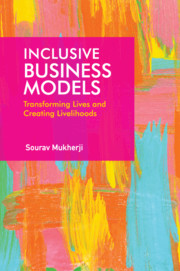Book contents
- Frontmatter
- Dedication
- Contents
- List of Tables
- List of Figures
- Preface
- Acknowledgements
- 1 Introduction
- 2 Vaatsalya Hospitals: Affordable Healthcare in Proximity
- 3 Gyan Shala: Providing Inclusive Education
- 4 Rang De: Creating a Platform for Social Investing
- 5 Labournet: Empowering Informal Sector Labourers
- 6 Selco: Inclusive Model for Energy Access
- 7 Hasiru Dala Innovations: Improving Lives of Waste Pickers
- 8 Reliance Retail: Creating Inclusive Supply Chain
- 9 International Development Enterprise (Ide) Nepal: Developing Smallholder Ecosystem
- 10 Ruralshores: Delivering Inclusive Service
- 11 Gujarat Narmada Fertilizer Company’s (Gnfc) Neem Initiative: A Social Business
- 12 Bringing it All Together
- References
- Index
4 - Rang De: Creating a Platform for Social Investing
Published online by Cambridge University Press: 31 July 2021
- Frontmatter
- Dedication
- Contents
- List of Tables
- List of Figures
- Preface
- Acknowledgements
- 1 Introduction
- 2 Vaatsalya Hospitals: Affordable Healthcare in Proximity
- 3 Gyan Shala: Providing Inclusive Education
- 4 Rang De: Creating a Platform for Social Investing
- 5 Labournet: Empowering Informal Sector Labourers
- 6 Selco: Inclusive Model for Energy Access
- 7 Hasiru Dala Innovations: Improving Lives of Waste Pickers
- 8 Reliance Retail: Creating Inclusive Supply Chain
- 9 International Development Enterprise (Ide) Nepal: Developing Smallholder Ecosystem
- 10 Ruralshores: Delivering Inclusive Service
- 11 Gujarat Narmada Fertilizer Company’s (Gnfc) Neem Initiative: A Social Business
- 12 Bringing it All Together
- References
- Index
Summary
Microfinance, or specifically microcredit, comprises lending small quantities of money to the poor to address their entrepreneurial or personal financing needs. In developing countries like India, the poor do not usually have access to formal sources of credit, which prevents them from undertaking any entrepreneurial activity that has the potential of increasing or diversifying their income. Microfinance can be considered as the poster child of inclusive business models, thanks to the pioneering effort of Muhammad Yunus, who, in 1983, established Grameen Bank in Bangladesh that showed the world that it was possible to build a profitable bank whose sole purpose was to provide micro-loans to the poor.
THE GRAMEEN BANK MODEL
Yunus, a professor of economics at the Chittagong University in Bangladesh, realized that small loans could have a significant positive impact on the lives of the poor during his visit to the nearby village of Jobra. There, he met poor women who were involved in making bamboo furniture. However, since they did not have access to formal credit, they needed to take loans from moneylenders to buy bamboo, the raw material. The moneylenders charged them such exorbitant rates of interest that the women could hardly make any profits and continued to remain poor. Yunus lent USD 27 to 42 such women, which resulted in them earning profits from their businesses for the first time. This led Yunus to investigate the systemic problems that resulted in the poor's inability to get formal credit and what could be done to overcome those problems.
There are several problems that prevent a poor person from getting credit from formal financial institutions, such as a bank. The poor usually do not have assets that they can pledge to the banks as collateral, nor do they have any credit history for the lender to rely on. Therefore, they are viewed as high-risk borrowers. Moreover, the loans that they need are typically of small denominations, which implies that the income that the bank can earn from the interest on such loans was meagre, compared to the transaction costs that the lender would incur in evaluating the borrower or for processing the loan. This compels the poor to borrow from informal sources, such as friends and family members, and, very often, from moneylenders.
- Type
- Chapter
- Information
- Inclusive Business ModelsTransforming Lives and Creating Livelihoods, pp. 72 - 102Publisher: Cambridge University PressPrint publication year: 2021

